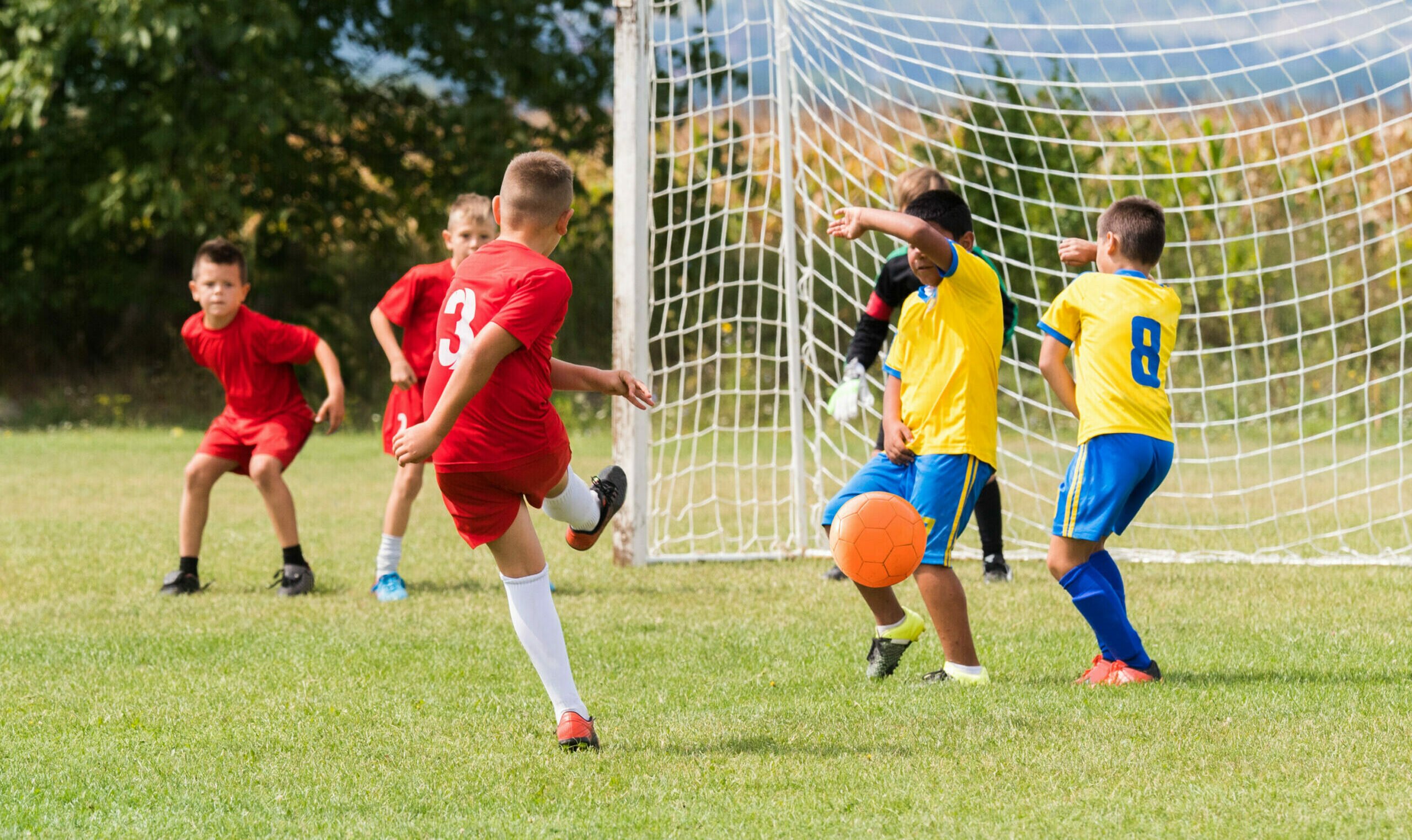Put me in, coach! Just don’t stress me out
Reviewed by Robert Bogenberger, PhD


Thud. Thud. Thud. Whoosh!


For years, this was the soundtrack to Sarah’s life during most of the spring and summer: her daughter, Annaliese*, casually playing basketball in the driveway with a few friends. The bounce of the ball, punctuated by an occasional giggle, made Sarah smile.
From a young age, Annaliese had been drawn to basketball. “We signed her up for a recreational league. She loved it so much that when she turned seven, we put her in a travel league,” says Sarah.
Thousands of dollars and many missed vacations and holidays later, she and her husband, Mark, had discovered the downside of competitive youth sports.
“What finally made us step back and say ‘There’s a problem’ is when we saw Annaliese losing her love of the sport,” Sarah says. “Those backyard pickup games stopped. She was fixated on perfecting her form and competing against other players—it had become serious business. The fun was no longer there.” She and Mark pulled Annaliese from the league shortly after.
More than 50% of American kids participate in an organized sport.1 With club and travel leagues demanding much more of athletes and their families, parents and mental health experts are starting to wonder if ultracompetitive sports may be doing kids more harm than good.
Mental health risks for young athletes
It’s commonly understood that playing a sport has a positive effect on your physical health, mood, and mental health.2 But Bill Reichle, LPC, a former player and youth coach who specializes in counseling student-athletes, says the more competitive leagues also carry risks for some kids.
“There’s a lot of pressure on these young people to be the best, and it’s coming from many different sources,” says Reichle. Social media, parents, and coaches all contribute, but these athletes may be hardest on themselves. “That mentality of always having to get better can create pressure and cause things like headaches, stress, depression, and more,” he says.
Playing can also result in burnout, especially if a child has zeroed in on a single sport. “There’s been this trend over the last couple of decades of kids ‘specializing’ at younger and younger ages in one sport and playing it year-round,” says athlete and former coach Linda Flanagan, author of “Take Back the Game.” “I have a friend who runs a lacrosse camp for kindergarteners, and she gets calls from frantic parents worried they’re too late in getting their kids involved in sports.” In addition to burnout, this early immersion can also result in physical injuries—not to mention reducing a kid’s curiosity about other sports.
An increased chance of self-harm
Reichle says cases of self-harm in young athletes may be an indication that the child is feeling overwhelmed or wants to leave a sport, but doesn’t know how to tell their parents or coaches.
“If you spot bruising that doesn’t match the game, that could raise a red flag,” says Reichle. “For example, your kid is saying they slipped or fell on the court, and the bruise doesn’t really look like that—maybe the lines are too symmetrical.”
Other forms of self-harm can be trickier to spot, especially when they involve food and weight. According to the National Eating Disorders Association, college athletes are more likely to have an eating disorder or engage in some form of disordered eating.3 Higher-risk sports tend to focus on individual performance, such as track, dance, or gymnastics, or on endurance, like running or swimming.4
Get help now
If you suspect your child is self-harming, find support right away by calling or texting the free, confidential 988 Lifeline at 988. If you think your child may have an eating disorder, text “HOME” to 741741 to connect with a trained volunteer at the Crisis Text Line. You can also reach out to a therapist for support.
Increased pressure on athletes’ families
Competitive youth sports can monopolize a family’s time, budget, and attention. The level of intensity varies depending on the size and requirements of the league or club, but Flanagan sees the following issues across the board.
Sports take up a lot of time. When a child joins a competitive league, it means a serious commitment for everyone in the family. Some parents of high-achieving athletes say they spend up to 20 hours a week on their child’s sport.5 Not only does the child need rides to and from games and practices, but “more and more of these leagues are traveling to tournaments and out-of-state competitions,” Flanagan says.
“Annaliese’s schedule was grueling,” Sarah confirms. “It left little room for family events and other extracurricular activities that could have been beneficial.”
Sports are expensive. “Mark and I spent so much money on Annaliese’s basketball career,” Sarah says. “We had to pay for team fees, uniforms, equipment, and transportation, all for my daughter to play in tournaments and games that may or may not have landed her on college scouts’ radars.” These costs leave many families on the sidelines: According to a recent survey, 57% of six-figure-earning parents reported that their child would play sports in the upcoming fall season, while only 27% of families who make $35,000 or less said their child would play.6
Sports require a ton of attention. A parent’s attention is one of the most valuable resources we can give our kids. In many households with a student-athlete, Flanagan says, siblings don’t get the same amount of focus: “There’s this tension about how we’re allocating resources. What if one of the kids doesn’t play sports?” The nonathlete in the house may feel left behind as their parents travel to games and prioritize the athletic sibling’s needs.
The myth of college scholarships
Flanagan says a lot of people encourage their kids to play at this level in pursuit of a college scholarship. In reality, less than 2% of high school student-athletes receive scholarships, and only 7% of high school athletes even go on to play at the collegiate level.7 “So parents think, ‘If I invest $15,000 in my child’s soccer career, it will pay off when they get to college’—but that’s not the case,” says Flanagan.
Then, of course, there’s the huge role that privilege plays in competitive sports. As noted above, many of the athletes playing at this level are not the ones who need help paying for college. They tend to come from educated families with higher income levels.8
Protective measures go a long way
If your child loves a sport, it’s hard to deny them the chance to play. So what can you do as a parent to help keep the pressure down? Flanagan and Reichle agree that kids can find a way to stay in the game, even at competitive levels, as long as certain protective factors are in place.
Keep communication lines open. The best way to support your child is to make it clear you’ll support them if they decide to quit. “Make sure they know you’re on board, even if they stop all this tomorrow,” says Reichle. “Reassure them: ‘I believe in you, and I’ll still believe you’re a really good athlete even if you don’t play.’ That goes a long way.” Being honest about the low likelihood of getting a college scholarship or playing professionally will also help your kids manage their own expectations.
Put boundaries in place for both of you. This might include no extra practices, saying no to tournaments on or near holidays, or otherwise protecting your child and their time. “When you set a boundary and it’s upheld by the other person, there’s respect,” Reichle says. “And if you set a boundary as a parent and the coach says ‘Get off my team,’ were they really in your kid’s corner?” Flanagan suggests that joining forces with other like-minded parents and setting boundaries as a group can be more effective.
Start therapy proactively. When our kids are serious about a sport, we make sure they have all the gear they need. This should include mental health support. “Counseling is just as important as the right trainer and the right coach,” says Reichle. Working through challenges like perfectionism and self-doubt with a therapist can be game-changing.
“I talk with athletes about the process, not the results,” Reichle says. “If you’re putting the right stuff into your routine, whether it’s positive self-talk, stretching, sleeping, or eating healthfully, then you can trust in that and know it’s going to yield better results.” Fundamentally, it also promotes behaviors that will help safeguard your child’s mental and physical health.
To find a therapist near you, browse our directory.
Keeping the fun in the game
When I was growing up, Saturday mornings meant setting up a makeshift baseball diamond in an empty lot on my street and playing for hours with other neighborhood kids. We weren’t being scouted or watched, and we didn’t even keep score half the time. We just had fun, like Annaliese and her friends shooting hoops in the driveway.
Creating the space for your child to explore and play a sport may be harder outside of formal leagues, but it can be done. You can help show them the positive side of play by encouraging pickup games, having equipment at your house, and even getting in the game yourself. It’s also worth exploring recreational leagues, which come with much less pressure.
“It broke my heart when Annaliese stopped playing basketball,” says Sarah. “But to watch her now, playing soccer with a rec league, has been wonderful. She’s smiling and happy, and she looks like my kid again.”
*Name has been changed.

Sources
1 https://www.cdc.gov/nchs/products/databriefs/db441.htm/
2 https://health.gov/sites/default/files/2020-09/YSS_Report_OnePager_2020-08-31_web.pdf
3 https://www.nationaleatingdisorders.org/athletes-eating-disorders/
4 https://www.nationaleatingdisorders.org/eating-disorders-athletes/
5 https://www.ncbi.nlm.nih.gov/pmc/articles/PMC4210977/
6 https://www.lendingtree.com/debt-consolidation/sports-fans-survey/
7 https://www.ncsasports.org/recruiting/how-to-get-recruited/scholarship-facts/
8 https://news.osu.edu/want-to-play-college-sports-a-wealthy-family-helps/
About the author
Amye Archer, MFA, is the author of “Fat Girl, Skinny” and the coeditor of “If I Don’t Make It, I Love You: Survivors in the Aftermath of School Shootings,” and her work has appeared in Creative Nonfiction magazine, Longreads, Brevity, and more. Her podcast, “Gen X, This Is Why,” reexamines media from the ’70s and ’80s. She holds a Master of Fine Arts in creative nonfiction and lives with her husband, twin daughters, and various pets in Pennsylvania.
Related articles

It isn’t easy to learn self-care. Sometimes, you need to go through a fiery...

What is digital self-harm, and why are teens doing it?
In an alarming new trend, teens are posting harmful content about themselves...

Ask a Therapist: Fears and anxieties
Join host Amye Archer and guests Kevin Chapman and Ilyse Kennedy for insightful...

Why you and your teenager both need a therapist
It’s crucial to support your teen’s mental health—but don’t forget...
